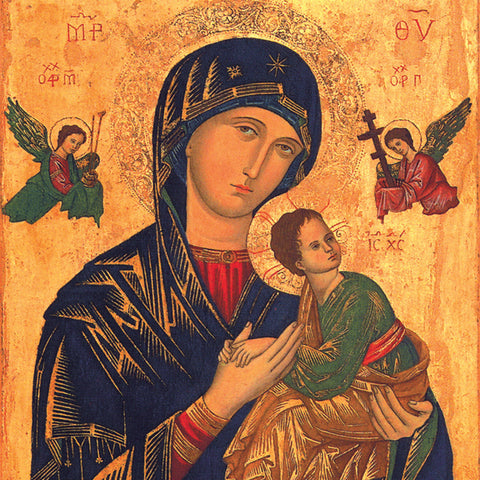Many religious icons stand out for their significance and spiritual allure, but few command the veneration and devotion bestowed upon the Icon of Our Mother of Perpetual Help. Through the centuries, this profound image has not only been a beacon of faith but has also been the source of countless miracle stories that attest to its divine intercession.
Let us delve into the rich history and miraculous nature of this icon.
The Icon of Our Mother of Perpetual Help, also known as the Icon of the Theotokos of the Passion, traces its origins back to 15th-century Crete, Greece. From Crete, it was brought to Rome in the late 15th century by a pious merchant who, according to a miraculous vision, was instructed to place the icon in a church between the Basilicas of St. Mary Major and St. John Lateran in Rome. The icon eventually found its home in the Church of St. Matthew the Apostle, where it was venerated for nearly 300 years until the church was destroyed in the Napoleonic wars.
In 1866, Pope Pius IX entrusted the icon to the Redemptorist Order at the Church of St. Alphonsus, not far from St. Matthew’s. The Pope asked them to "make her known throughout the world," a mission they have faithfully carried out.
The icon is a work of intricate artistry. The Madonna, clothed in a dark red tunic and blue mantle - the colors of virginity and motherhood in Byzantine iconography - gazes directly at us, holding the Child Jesus. The child, while divinely serene, clings to his mother, his sandal dangling loosely, symbolizing the instability of human life. The angelic figures of Michael and Gabriel hold the instruments of the Passion, indicating the future suffering of Jesus.
What sets this icon apart is not just its history or its artistry, but the countless miracle stories associated with it. A miracle that stands out took place in the late 1800s. A certain Roman woman, in an act of desperation, stole the icon from the church to cure her paralyzed daughter. The daughter was indeed cured, but the icon was returned to the church after a vision compelled the woman to do so. Ever since, the icon has been revered as a symbol of divine intervention and healing.
In another tale, during World War II, a bomb dropped near the Church of St. Alphonsus in Rome, where the icon was housed. Although the church suffered extensive damage, the chapel where the icon resided remained miraculously untouched, inspiring countless faithful during the distressing years of the war.
In more recent years, devotees from around the world have reported miraculous healings, answered prayers, and profound conversions attributed to Our Mother of Perpetual Help. These stories serve as a testament to the enduring power and relevance of this venerable icon.
The Icon of Our Mother of Perpetual Help is more than just a religious artifact; it is a symbol of perpetual hope and divine help. It is a beacon of light guiding us through the storms of life, a reminder of the divine motherly love that perpetually reaches out to assist us in our earthly struggles.
The rich tapestry of history, art, and miracles woven into the Icon of Our Mother of Perpetual Help makes it not just an object of religious reverence, but a catalyst of faith and a testament to the unending love and power of Our Mother. As we venerate this icon, we are reminded of the countless miracles interwoven with its existence and its ever-present help that perpetually flows to us in our moments of need.

